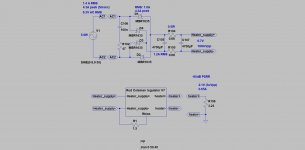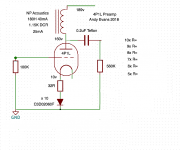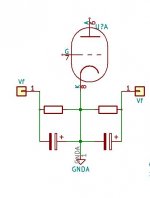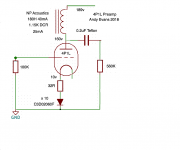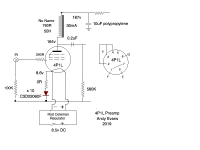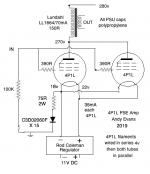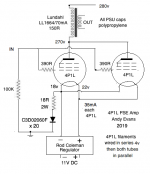It's OK - no need for a resistor here.
Thank you Rod.
All your input on this thread is great.
Try the 26 with 10 diodes and a 120R resistor. I don't find it masks the sound - on the contrary, it's super detailed. You can decrease the number of diodes as shown. This is normal bias - not filament bias - and I'm sure that also comes into it. The resistors have tiny current through them, so you can use any kind of boutique ones you fancy. I've only used 120R so far, but intend to try different combinations of resistor/diode. This is now my daily preamp.
Thanks to share Andy. What's the power required for the resistor?
???
Hi Dear Euro21, in this case, which is the internal resistance of every diode? Sorry I am newbie could you explain it?
Best Regards
Best Regards
Depends of current and type of diode, but almost in Ohm's range.
For example basic Cree SiC diode dynamic resistance about 1R5 in the 10-100mA region.
For example basic Cree SiC diode dynamic resistance about 1R5 in the 10-100mA region.
I need to ask how to correctly calculate the load for Rods filament regulators used in filiment bias.
Do I calculate the heater load plus the the operating point of the tube, as in say for a 2P29L 2 volts at 15 Miliamps to come up with a dummy load to test the regs before firing up the tubes?
Thanks
Ed
Do I calculate the heater load plus the the operating point of the tube, as in say for a 2P29L 2 volts at 15 Miliamps to come up with a dummy load to test the regs before firing up the tubes?
Thanks
Ed
Hi Ed,
The cathode current is mostly negligible. Calculate dummy load with Ohm's law: Rdummy= filament voltage / filament current.
Sample: 4P1L filament
If you use filament bias, the filament current will flow trough filament (DC resistance) + bias resistor. The cathode is negative (compared to grid) about Rbias*Iheater + (Vheater/2), so this determines the op. point (grid voltage) curve.
The cathode current is mostly negligible. Calculate dummy load with Ohm's law: Rdummy= filament voltage / filament current.
Sample: 4P1L filament
If you use filament bias, the filament current will flow trough filament (DC resistance) + bias resistor. The cathode is negative (compared to grid) about Rbias*Iheater + (Vheater/2), so this determines the op. point (grid voltage) curve.
Attachments
Last edited:
The cathode current is mostly negligible. Calculate dummy load with Ohm's law: Rdummy= filament voltage / filament current.
Thank you. Makes sense now.
Ed
I just took another look at this using SIC diode bias. I haven't built it, but intend to since I'm getting good results with the same circuit and a 26 tube. The output impedance with a plate choke might just be enough to drive a solid state amp. Thoughts and comments?
Attachments
Well, I got the 4P1L line stage built with SIC diode bias. Listening tests are very positive - the sound is smooth, detailed, clean and solid. I broke out in a smile when I put it in my system - good sign! So I recommend this. As a plate choke design it has a lower output impedance than 01A or 26 designs, which could be useful. I recommend this. The plate choke I'm using is a no-name of Asian origin. Sounds fine to me. I haven't tried my NP Acoustics amorphous plate choke yet, but I intend to do so.
Attachments
I finally got the last bits done on my 2p29l preamp. Coleman regs, choke loaded. Thank you Rod, Ale, and all the contributors to this long thread. I do have a question for the experts. I am using Rod's regs in filament bias. When I was setting the voltage I have the rectifier removed. With no B+ on the plate I had a steady 2V. With 154 volt at the plate I now have 2.75v filament. Any recommendation?
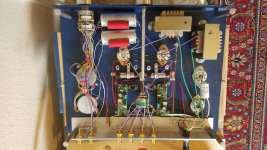
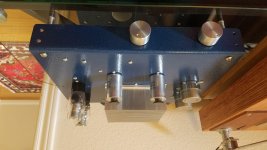


Weird, I'm not sure why it would do that. Pre-amp looks awesome, congrats!
Which chokes did you use?
Which chokes did you use?
Well, I got the 4P1L line stage built with SIC diode bias. Listening tests are very positive - the sound is smooth, detailed, clean and solid. I broke out in a smile when I put it in my system - good sign! So I recommend this. As a plate choke design it has a lower output impedance than 01A or 26 designs, which could be useful. I recommend this. The plate choke I'm using is a no-name of Asian origin. Sounds fine to me. I haven't tried my NP Acoustics amorphous plate choke yet, but I intend to do so.
Nice experiments Andy. It'd be worth trying the SiC array as filament bias as well. I'm sure they will sound as good or even better.
Cheers
Ale
One of the next things to do is put SIC diodes in the PSE 4P1L output stage.
The challenge is the number of SiC diodes needed, I thought about it. I think you'd add too much output impedance as 75R reflected in the anodes will be close to 750R on top of the 4P1L output impedance (which is halved due to the parallel arrangement. In the end it would be worse than one single valve. Worth trying as probably with the OPT you have it will still have good bass.
Ale
- Home
- Amplifiers
- Tubes / Valves
- 4P1L DHT Line Stage
